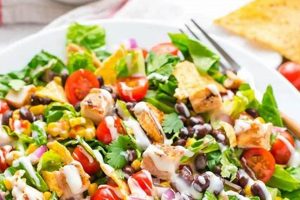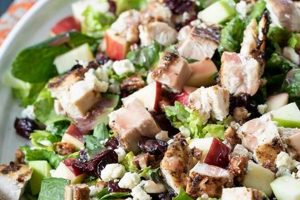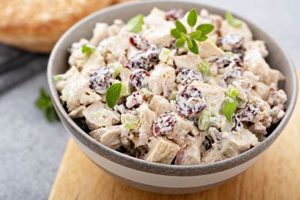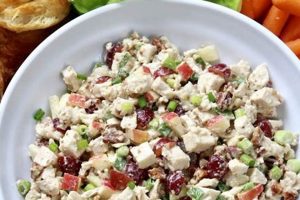A classic American dish, this salad typically combines cooked chicken, mayonnaise (often Miracle Whip brand), and various other ingredients. Common additions include celery, onion, grapes, nuts, and seasonings. Variations exist, substituting or adding ingredients like apples, cranberries, or different herbs and spices, reflecting diverse regional and personal preferences. A simple yet satisfying meal, it can be enjoyed as a sandwich filling, on crackers, or as a light meal on its own.
This type of salad offers a convenient and adaptable way to utilize leftover cooked chicken. Its popularity stems from its ease of preparation, affordability, and customizable nature. Emerging in the mid-19th century, initially as a more elaborate and expensive dish, it evolved over time to become a staple in many households, especially with the advent of commercially produced mayonnaise and readily available ingredients. The use of Miracle Whip, a tangier mayonnaise-like salad dressing, adds a distinctive flavor profile that many find appealing.
The following sections will explore variations on this classic dish, offering detailed recipes, tips for ingredient selection and preparation, and suggestions for presentation and serving.
Tips for a Superior Chicken Salad
Elevating this simple dish to culinary excellence involves attention to detail and a few key techniques. The following tips offer guidance for achieving optimal flavor and texture.
Tip 1: Chicken Selection and Preparation: Using high-quality, properly cooked chicken is paramount. Rotisserie chicken offers convenience, while poaching or baking boneless, skinless breasts allows for controlled seasoning and moisture retention. Avoid overcooking, which results in dry, stringy meat.
Tip 2: Balancing Flavors: Miracle Whip’s tangy sweetness provides a foundation. Balance this with the savory notes of celery, onion, and seasonings. Fresh herbs like dill or chives add complexity.
Tip 3: Texture Considerations: Achieve desired texture through chopping techniques. A coarser chop provides heartier mouthfeel, while finely diced ingredients create a smoother consistency. Consider adding textural contrast with nuts or grapes.
Tip 4: Ingredient Ratios: The ratio of chicken to other ingredients impacts the overall experience. Too much dressing can make the salad soggy, while too little can result in dryness. Start with a smaller amount of dressing and add more as needed.
Tip 5: Chill Time: Allowing the salad to chill for at least 30 minutes allows flavors to meld. This enhances the overall taste experience.
Tip 6: Creative Additions: Explore flavor profiles by incorporating dried cranberries, chopped apples, or toasted pecans. These additions contribute sweetness, tartness, and satisfying crunch.
Tip 7: Serving Suggestions: Consider serving the salad on croissants, in lettuce cups, or with crackers. These versatile options provide varied presentation and enhance the dining experience.
By following these tips, one can create a chicken salad that transcends the ordinary and provides a truly satisfying culinary experience.
This exploration of ingredient selection, flavor balancing, and presentation techniques provides a foundation for creating a memorable chicken salad experience.
1. Chicken (cooked, diced)
Chicken serves as the foundational ingredient, providing the primary protein source and influencing the overall texture and flavor profile. The preparation method and handling of the chicken significantly impact the final quality of the salad.
- Cooking Methods
Various cooking methods yield different results. Poaching or baking retains moisture and allows for controlled seasoning, while rotisserie chicken offers convenience. Overcooking should be avoided, as it results in dry, stringy meat that detracts from the salad’s quality.
- Dicing Technique
The size of the diced chicken influences both texture and flavor distribution. Larger pieces provide a more substantial mouthfeel, while smaller pieces offer a smoother, more evenly blended flavor experience. Consistent dicing ensures uniform texture and appearance.
- Chicken Quality
The quality of the chicken directly impacts the overall flavor and enjoyment. Fresh, high-quality chicken contributes a cleaner, more appealing taste. Using leftover chicken presents a sustainable option, but ensuring its proper storage and freshness remains crucial.
- Flavor Absorption
Cooked chicken readily absorbs flavors from other ingredients. This characteristic allows the chicken to meld seamlessly with the Miracle Whip, celery, onion, and any additional seasonings, creating a cohesive and flavorful salad.
Properly cooked and diced chicken ensures the salad achieves optimal flavor, texture, and overall appeal. Attention to these details elevates the final dish from simple to exceptional.
2. Miracle Whip (dressing)
Miracle Whip, a tangy, sweet salad dressing, plays a defining role in this specific type of chicken salad. Its unique flavor profile, distinct from traditional mayonnaise, contributes a characteristic sweetness and tang that complements the other ingredients. This dressing acts as a binding agent, holding the components together while simultaneously imparting its signature flavor. The choice of Miracle Whip over mayonnaise significantly alters the overall taste experience, resulting in a salad that is both recognizable and distinct. For example, a chicken salad made with Miracle Whip will possess a noticeably sweeter and tangier flavor compared to one made with mayonnaise, impacting overall palatability. This distinction often drives recipe selection based on individual flavor preferences.
The quantity of Miracle Whip used also influences the salad’s texture. Too much dressing can lead to a soggy consistency, while too little can result in a dry, less cohesive mixture. Achieving the proper balance ensures a pleasant textural experience. This balance contributes to the salad’s overall appeal, impacting its suitability for various applications such as sandwiches or crackers. Furthermore, the interaction between Miracle Whip and other ingredients, such as celery and onion, creates a complex flavor dynamic. The tanginess of the dressing enhances the savory notes of these vegetables, contributing to a balanced and well-rounded flavor profile.
Understanding the role of Miracle Whip in this recipe is essential for achieving the desired flavor and texture. The interplay between this dressing and other components significantly contributes to the final products character. Successfully leveraging Miracle Whip’s unique properties ensures a chicken salad that delivers the anticipated tangy, sweet, and satisfying experience characteristic of this popular variation. Careful consideration of quantity and its interaction with other ingredients allows for adjustments to suit individual preferences, solidifying its crucial role in the recipe’s adaptability and enduring appeal.
3. Celery (chopped)
Celery, specifically chopped celery, plays a crucial role in the flavor and textural profile of chicken salad made with Miracle Whip. Its inclusion contributes a distinct freshness and satisfying crunch, balancing the richness of the dressing and chicken while adding a vegetal complexity.
- Flavor Contrast
Celery’s slightly bitter, herbaceous flavor provides a counterpoint to the sweetness of Miracle Whip and the savory chicken, creating a balanced flavor profile. This contrast prevents the salad from becoming overly sweet or rich. The subtle bitterness of celery also enhances the overall complexity of the dish, preventing a one-dimensional flavor experience.
- Textural Enhancement
Chopped celery introduces a crisp, refreshing texture that contrasts with the softer textures of the chicken and dressing. This textural variation makes each bite more dynamic and enjoyable. The degree of chop influences the textural impact; a finer chop offers a milder crunch, while a coarser chop provides more pronounced textural contrast.
- Moisture and Volume
Celery contributes moisture and volume to the salad, helping to prevent it from becoming too dense or dry. This characteristic allows for a lighter, more refreshing salad experience. The moisture content of celery also aids in binding the ingredients together, contributing to a cohesive texture without requiring excessive amounts of dressing.
- Nutritional Value
Beyond flavor and texture, celery adds nutritional value to the salad. It is a good source of fiber and vitamins, contributing to a more nutritious and well-rounded meal. While not a primary nutritional focus of the dish, the inclusion of celery offers added health benefits, aligning with broader dietary considerations.
The strategic incorporation of chopped celery elevates the chicken salad beyond a simple combination of ingredients. Its contributions to flavor, texture, and nutritional value highlight its essential role in creating a well-balanced and satisfying dish. The interplay between celery and the other components, particularly the Miracle Whip, showcases the importance of ingredient selection in achieving a harmonious and flavorful final product.
4. Onion (diced)
Diced onion contributes a pungent, savory depth to chicken salad incorporating Miracle Whip. Its sharp flavor profile balances the sweetness of the dressing and richness of the chicken, adding complexity and preventing the overall flavor from becoming cloying. The choice of onion variety influences the intensity of this effect; for example, a red onion imparts a sharper, more assertive flavor compared to a milder sweet onion. This allows for customization based on individual preference and desired intensity. The dicing process itself affects both texture and flavor release. Finely diced onion disperses flavor more evenly throughout the salad, while a coarser chop provides a more pronounced textural presence and concentrated bursts of flavor. This textural element adds to the overall sensory experience of the dish. The quantity of onion used further modulates the final flavor profile, with a higher proportion yielding a more pronounced onion flavor.
Beyond flavor, onion also contributes to the structural integrity of the salad. Its moisture content, released during the dicing process, helps bind the ingredients together, enhancing the salad’s cohesiveness without relying solely on the dressing. This binding effect prevents the salad from becoming excessively loose or watery, particularly after chilling. Furthermore, the presence of onion can subtly influence the perceived freshness of the salad. Its crisp texture and pungent aroma contribute to an overall impression of vibrancy and recently prepared ingredients. This perception of freshness can enhance the overall appeal and enjoyment of the dish. In practical application, the careful balance of onion within the recipe demonstrates a culinary understanding of balancing flavors and textures.
Careful consideration of onion variety, dicing technique, and quantity are crucial for achieving a balanced and flavorful chicken salad. The interplay between the onion’s pungent notes and the other ingredients, particularly the Miracle Whip, highlights its essential role in shaping the final flavor profile. Understanding these nuances enables informed choices that optimize both taste and texture, resulting in a more satisfying culinary experience. Failure to properly integrate the onion can lead to an unbalanced flavor profile, either overly bland or excessively pungent, demonstrating the practical significance of these considerations.
5. Seasoning (salt, pepper)
Seasoning, primarily salt and pepper, plays a crucial role in a chicken salad recipe utilizing Miracle Whip. Salt enhances the inherent flavors of the chicken, celery, and onion, while pepper adds a subtle layer of complexity and spice. The interplay between these seasonings and Miracle Whip’s tangy sweetness is essential for a balanced flavor profile. Insufficient seasoning can result in a bland salad, failing to showcase the potential of the individual ingredients. Conversely, excessive seasoning can overpower the delicate flavors, creating an unpleasantly salty or peppery experience. Consider a scenario where salt is omitted: the natural sweetness of the Miracle Whip may become dominant, obscuring the savory notes of the chicken and vegetables. Adding black pepper introduces a contrasting element, balancing the sweetness and adding depth. A classic example demonstrating the importance of seasoning is the noticeable difference between a commercially prepared, often under-seasoned, chicken salad and a homemade version where salt and pepper are adjusted to taste.
The type of salt used can further influence the final outcome. Table salt provides a straightforward saline taste, while kosher salt, due to its larger crystal size, offers a more nuanced salinity and dissolves more slowly, allowing for greater control during the seasoning process. Freshly ground black pepper delivers a more robust aroma and flavor compared to pre-ground pepper, enhancing the overall sensory experience. Practical application necessitates tasting and adjusting seasoning throughout the preparation process. Initial seasoning of the chicken before incorporating other ingredients ensures a foundational flavor base. Further adjustments after combining all elements allow for fine-tuning the overall balance, accounting for variations in ingredient freshness and individual preferences. This iterative approach underscores the crucial role of active seasoning in achieving a well-balanced and flavorful salad.
Effective seasoning is integral to a successful chicken salad incorporating Miracle Whip. It elevates the individual components and creates a harmonious blend of flavors. Understanding the interplay between salt, pepper, and the other ingredients allows for precise control over the final flavor profile, resulting in a more satisfying culinary outcome. Overlooking this seemingly simple step can significantly impact the overall quality and enjoyment of the dish, underscoring the practical significance of proper seasoning techniques.
Frequently Asked Questions
This section addresses common inquiries regarding chicken salad prepared with Miracle Whip, offering concise and informative responses.
Question 1: What is the ideal ratio of Miracle Whip to chicken?
The optimal ratio depends on personal preference, but a general guideline is to start with 1/2 cup of Miracle Whip per 2 cups of diced chicken. Adjustments can be made to achieve desired consistency and flavor intensity.
Question 2: Can other dressings be substituted for Miracle Whip?
While substitutions are possible, they will alter the characteristic flavor profile associated with Miracle Whip. Mayonnaise or other salad dressings can be used, but the resulting taste will differ.
Question 3: How long can chicken salad with Miracle Whip be stored?
Properly stored in an airtight container in the refrigerator, this salad typically lasts for 3-5 days. Spoilage signs include discoloration, off-odors, or changes in texture.
Question 4: How can one reduce the sodium content?
Lower-sodium versions of Miracle Whip are available. Additionally, using fresh ingredients and minimizing added salt during preparation contributes to sodium reduction.
Question 5: What are common alternatives to celery and onion?
Chopped apples, grapes, or water chestnuts offer textural and flavor variations while maintaining a crisp, refreshing element. Bell peppers can also provide a milder alternative to onion.
Question 6: Can canned chicken be used?
While canned chicken offers convenience, it often possesses a different texture and flavor profile compared to freshly cooked or rotisserie chicken. Draining and rinsing the canned chicken thoroughly can improve its integration into the salad.
Understanding these common questions facilitates informed recipe adaptation and ensures a successful outcome when preparing chicken salad with Miracle Whip. Attention to ingredient selection, storage practices, and flavor adjustments allows for customization based on individual preferences and dietary needs.
This FAQ section provides a foundational understanding of key aspects related to this recipe. The subsequent sections will delve into specific recipe variations and offer advanced techniques for elevating the dish further.
Chicken Salad Miracle Whip Recipe
Exploration of this classic recipe reveals the interplay of seemingly simple ingredients to create a complex and satisfying dish. Ingredient selection, preparation techniques, and the crucial role of Miracle Whip in shaping the characteristic flavor profile have been examined. From the foundational elements of chicken and dressing to the nuanced contributions of celery, onion, and seasonings, each component contributes to the final product’s overall quality and enjoyment. Understanding these elements allows for informed adjustments and personalized variations, catering to individual preferences and dietary considerations. The frequently asked questions section addressed common concerns, providing practical guidance for successful preparation and storage.
This examination underscores the potential for culinary artistry within seemingly simple recipes. Careful consideration of ingredients, techniques, and flavor profiles elevates everyday dishes beyond the mundane. The enduring popularity of chicken salad made with Miracle Whip speaks to its adaptability and enduring appeal, inviting continued exploration and culinary creativity within the kitchen.






